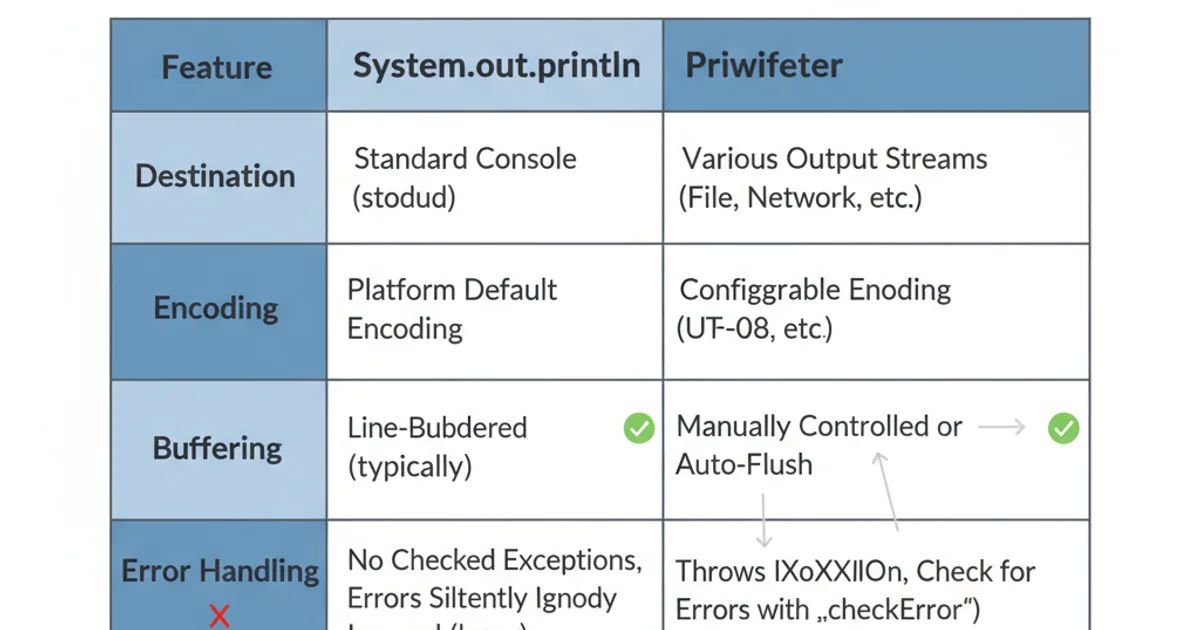System.out.println vs PrintWriter
Categories:
System.out.println vs. PrintWriter: Choosing the Right Output Stream in Java

Explore the fundamental differences between System.out.println and PrintWriter in Java, understanding their use cases, performance implications, and when to choose one over the other for robust I/O operations.
In Java programming, outputting data to the console or files is a common task. Two of the most frequently encountered mechanisms for this are System.out.println and java.io.PrintWriter. While both serve the purpose of writing text, they differ significantly in their capabilities, performance characteristics, and suitability for various scenarios. Understanding these distinctions is crucial for writing efficient, flexible, and maintainable Java applications.
Understanding System.out.println
System.out.println is perhaps the most basic and widely used method for printing output in Java. It's a convenience method provided by the PrintStream class, which is the type of the System.out object. It's primarily designed for quick debugging, simple console output, and educational purposes. It automatically flushes the output buffer after each line, ensuring that the text appears immediately on the console.
public class SystemOutExample {
public static void main(String[] args) {
System.out.println("Hello, World!");
int number = 123;
System.out.println("The number is: " + number);
}
}
Basic usage of System.out.println for console output.
System.out is a PrintStream, which is a byte-oriented stream. While println methods handle character encoding for you (using the platform's default charset), for explicit character encoding control, PrintWriter is often preferred.Introducing PrintWriter
PrintWriter is a character-oriented output stream that offers more advanced features and flexibility compared to System.out.println. It's part of Java's java.io package and is designed for writing formatted representations of objects to a text-output stream. Key advantages include the ability to specify character encoding, automatic flushing control, and the capacity to write to various underlying output destinations (files, network sockets, etc.) through composition with other Writer objects.
import java.io.FileWriter;
import java.io.IOException;
import java.io.PrintWriter;
public class PrintWriterExample {
public static void main(String[] args) {
try (PrintWriter writer = new PrintWriter(new FileWriter("output.txt"))) {
writer.println("This is written to a file.");
writer.printf("Formatted output: %d + %d = %d%n", 10, 20, 30);
writer.flush(); // Explicitly flush the buffer
} catch (IOException e) {
e.printStackTrace();
}
}
}
Using PrintWriter to write formatted output to a file.
flowchart TD
A[Application Code] --> B{"Output Destination?"}
B -- Console --> C[System.out.println]
B -- File/Network/Custom --> D[PrintWriter]
D --> E[FileWriter/OutputStreamWriter]
E --> F[File/Socket/Other Stream]
C -- Default Charset --> G[Console]
D -- Configurable Charset --> FDecision flow for choosing between System.out.println and PrintWriter.
Key Differences and When to Use Which
The choice between System.out.println and PrintWriter boils down to the specific requirements of your application. Here's a breakdown of their primary differences and recommended use cases:

Feature comparison between System.out.println and PrintWriter.
PrintWriter streams (or use try-with-resources) to ensure all buffered data is written and resources are released. Failing to do so can lead to lost output or resource leaks.Performance Considerations
For small, infrequent console outputs, the performance difference is negligible. However, when dealing with large volumes of output, especially to files or network streams, PrintWriter generally offers better performance due to its buffering capabilities. System.out.println's automatic flushing after every line can be inefficient for high-volume operations, as each flush operation can be costly.
In summary, while System.out.println is excellent for quick and dirty console output, PrintWriter provides a more robust, flexible, and performant solution for serious I/O operations, especially when writing to files or requiring specific character encodings and error handling.